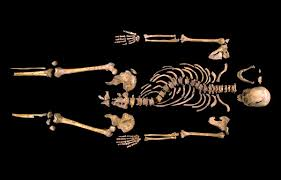Shakespeare Lied!

http://www.nytimes.com/2012/09/24/world/europe/discovery-of-skeleton-puts-richard-iii-in-battle-again.html?pagewanted=all&_r=0
The Lord of the Rings trilogy may be over, but this King has just come back and is returning daily through scientific efforts. This King is the long deceased Richard III, killed in a battle in the year 1485. The real magic of Richard’s story is amazing scientific work put into research on his corpse.
Richard’s body was found under a car park in August of 2012. Researchers described the burial as hastily done. The grave was too short for his body (forcing his head forward) and was too shallow (for a normal medieval grave). There was also no evidence of a coffin or shroud with which to protect the King. There are also suggestions, due to the placement of his hands (which were in an odd place for a Medieval burial), that they were tied at the time of his burial. This was most likely because he was the deposed king of England whose job had been taken by Henry IV.
It took scientists an entire year to prove that the remains they found underneath the car parking lot were actually the remains of Richard III. They did this by finding a living relative of Richard III and using the mitochondrial DNA in the decedent they found off of the skeleton. The decedent one, Michael Ibsen, is related to Richard through Richard’s eldest sister, Anne of York. They also used the carbon-14 to give them an approximate date of death.
The Richard III Society is a group people all around the world who believe that Richard III was wrongly epitomized by society and believe that Richard should be looked at in a new light. Phillipa Langley was the member of the society who fought to find the grave of Richard III. She, as well as many others, were very shocked when the skeleton of the king indeed had a spinal deformity.
In Shakespeare’s account, Richard had a hump back and a withered arm. In fact, Richard had scoliosis that developed around the age 10 to 13. Not exactly a hump back but a curvature of the spine. It would have put considerable pressure on his inner organs, causing him quite a bit of pain. The rumor of a withered arm was debunked by the skeletons arms being the same length, making a withered arm quite impossible.
The battle in which Richard III was killed was the Bosworth battle (the last king to die in battle). The scientists could tell that some of the wounds found on his body were from around the time of death (Bosworth battle), due to no sign of the wounds healing. There were 11 wounds on the skeleton (9 on the skull and 2 to the postcranial skeleton) from the battle, some possibly inflicted after death. One of these wounds was a humiliation wound delivered to the buttocks region likely after death when his corpse was flung over a horse.
Scientists believe that there were three head wounds that most likely were the cause of death. These wounds were probably caused by a sword, a staff weapon, or the tip of an edged weapon, for example a dagger. These wounds to the head suggest that he was not wearing a helmet at the time of his death, yet no defensive wounds on the arms and legs suggest that the rest of his body was covered in armor.
DNA from Richard III also brought up the faithfulness of the women in his family. This evidence of infidelity was found in the DNA of living relatives which have maternal-sided DNA but not any of the male side. This evidence could deny the Tudors and Richard III claims to the throne of England.
Many rumors circulate around the life of Richard III. Most of them are due to his main claim to fame: the unattractive portrayal of his short reign in Shakespeare’s play (creatively named) “Richard III.” In the play, Richard kills both of his brothers and his nephews in order to secure the throne for himself. The famous two princes that were supposedly killed by Richard III were in fact 12-year-old Edward V and his brother 9-year-old Richard, Duke of York, who went missing in 1483 after being imprisoned in the Tower of London. Two children’s bodies were found in the 1600s, however nobody knows what exactly happened to the two princes.
Richard’s reign was in fact the shortest reign, lasting only 26 months (about 2 years). He was deposed by Henry IV, the great great grandfather of Elizabeth I (the start of the Tudor dynasty). This is significant because Shakespeare lived during the reign of Elizabeth I, making it very possible that he wanted to appease the queen by making her ancestors look better. Richard III will be reburied in Leicester Cathedral in March of 2015.

Bonjourno! Me llamo Sophie. I am a tri(sort of) lingual senior with a large passion for sarcasm and baked goods. I still am in band, writers guild, link...













Nikol Podlacha • Jan 16, 2015 at 8:52 am
I can’t describe this article in words. It was deep, interesting and quite honestly blew my mind. Thank you my life would be at lost without this.